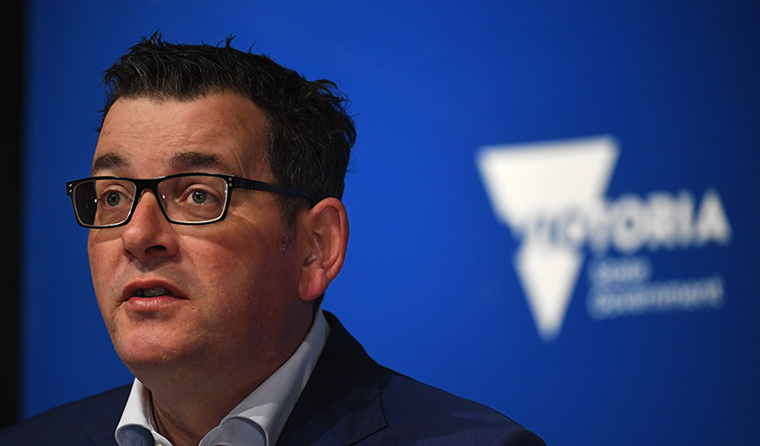News
‘This is a public health bushfire’: Victoria to rollout saliva test in COVID-19 blitz
The State Government is ramping up testing as daily case numbers continue to spike.
 As part of a 10-day testing blitz, up to 800 health workers will aim to conduct 10,000 tests a day for local residents with or without symptoms. (Image: AAP)
As part of a 10-day testing blitz, up to 800 health workers will aim to conduct 10,000 tests a day for local residents with or without symptoms. (Image: AAP)
Health workers will be going to door-to-door across 10 priority suburbs in Melbourne, collecting saliva samples for the detection of COVID-19.
Compared to the nasopharyngeal test, the saliva test is far less invasive and does not require testers to use as much personal protective equipment (PPE). It can be self-administered, requiring the patient to place their saliva in a cup.
Expected to rollout to the public from Monday 29 June, Victorian Premier Daniel Andrews said the new test would provide a ‘massive boost’ to the state’s capacity.
‘It’s a more pleasant experience than the current test,’ he said during a press conference on Thursday.
‘It won’t completely replace the current test, it won’t change the amount of time that the laboratory takes to analyse the test, but it will certainly reduce the time taken to take that sample, to actually conduct the test.’
Victoria recorded its ninth consecutive day of double-digit coronavirus cases on Thursday 25 June, with 33 new confirmed cases. It was the state’s biggest daily increase since the start of the latest spike last week, and the highest in two months. The number of suspected community transmissions dropped by one case overnight.
Seven of the state’s active cases have been hospitalised, with two people in intensive care. Nine are connected to known outbreaks, seven are in hotel quarantine, six are from routine testing and 11 remain under investigation.

Premier Daniel Andrews urged Victorians to take up the invitation to be tested, calling on them to see it as their ‘civic duty’. (Image: AAP)
Following urgent calls from GPs for location data on emerging cases, the state health department broke down the local government area hotspots into the 10 most affected suburbs:
- Keilor Downs
- Broadmeadows
- Maidstone
- Albanvale
- Sunshine West
- Hallam
- Brunswick West
- Fawkner
- Reservoir
- Pakenham
As part of a 10-day testing blitz, up to 800 health workers, including qualified and trainee nurses, will aim to conduct 10,000 tests a day, free of charge for local residents with or without symptoms.
The first three days of the program will focus on the two priority suburbs, Keilor Downs and Broadmeadows, with the aim to test half of the population.
Health workers will go door to door inviting residents to take a test, with ambulances and other vans set up at the end of people’s streets.
‘It’s bringing the testing to their home,’ Victoria’s Chief Health Officer Professor Brett Sutton said.
‘We are throwing everything at this. We are really focused on community cases, the cases where we don’t know the source of the infection.’
Premier Andrews urged Victorians to take up the invitation to be tested, calling on them to see it as their ‘civic duty’.
‘We will see numbers going up in the coming days, but that will be a measure of the success of this strategy,’ he said.
‘This is no less serious than a bushfire ... just like we sent air bombers and firefighters earlier this year ... this is a public health bushfire.’
The number of active cases in Victoria jumped from 58 to 143 between 17–24 June. These numbers are in stark contrast to the rest of the country, which recorded a combined increase of 20 in that same period.
NSW recorded four new cases on Thursday 25 June, three of which are returned travellers in hotel quarantine, while the fourth is a seven-year-old child. Queensland has not recorded any new infections in over a week, with just two active cases remaining in the state.
All other states and territories recorded zero new coronavirus cases.
Victoria has seen a surge in the number of people being tested, with pathology labs processing 18,000 tests a day. That capacity will increase to 25,000 tests a day with the help of NSW, South Australia, Tasmania and Queensland.
Australian Defence Force personnel will support the efforts, working with the Victorian Government to transfer tests to pathology labs.
With the local government hotspots home to large migrant communities, 1000 health workers have started knocking on doors to help raise awareness of the testing blitz with information translated into 55 languages.
Meanwhile, statewide efforts will continue across more than 130 testing locations, with authorities working to open additional sites.
Log in below to join the conversation.
blitz coronavirus COVID-19 saliva
newsGP weekly poll
What is your chief concern with role substitution?